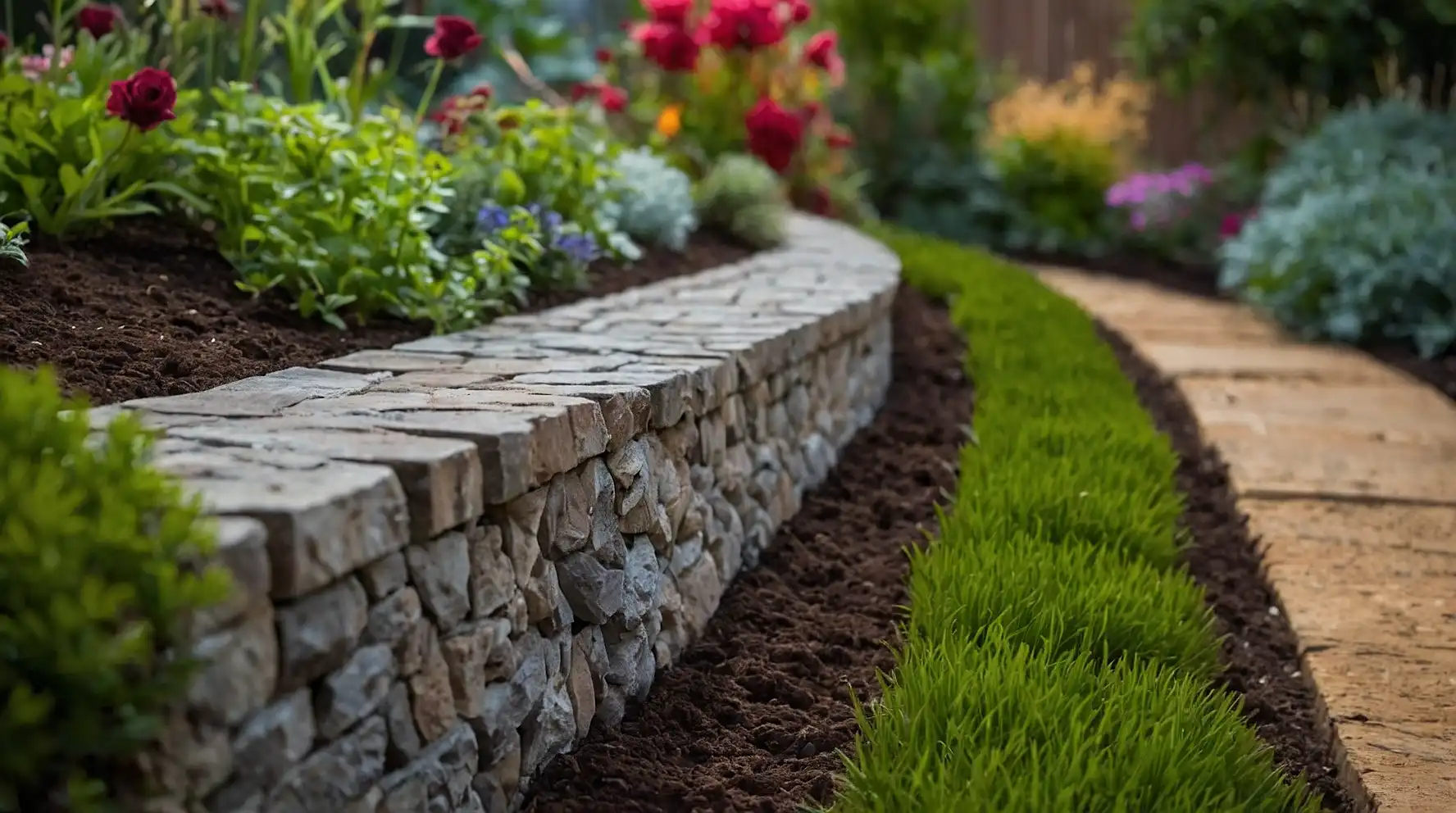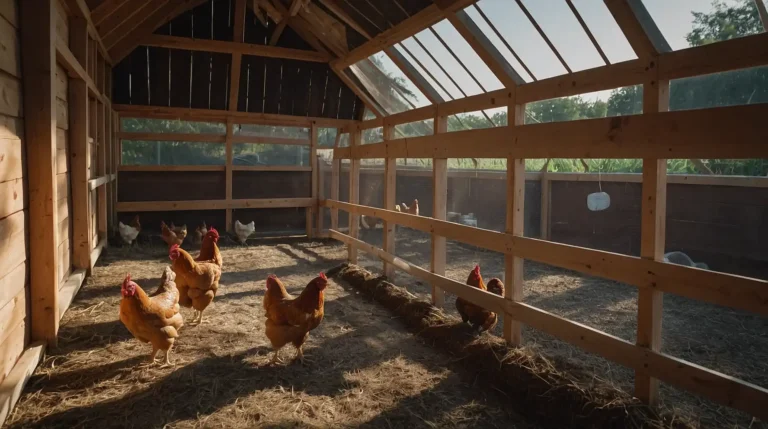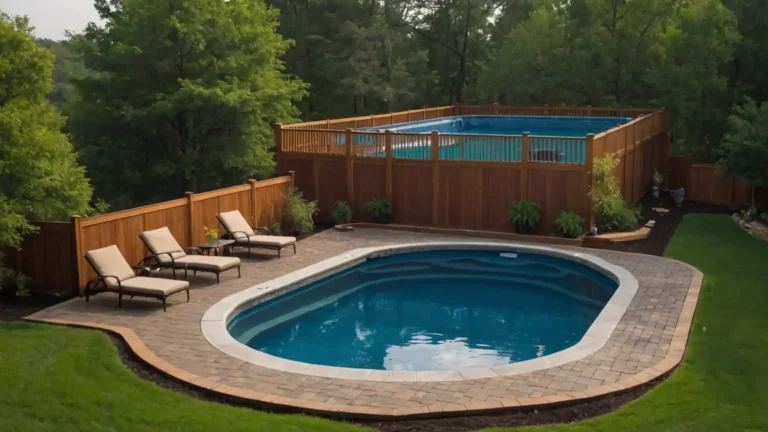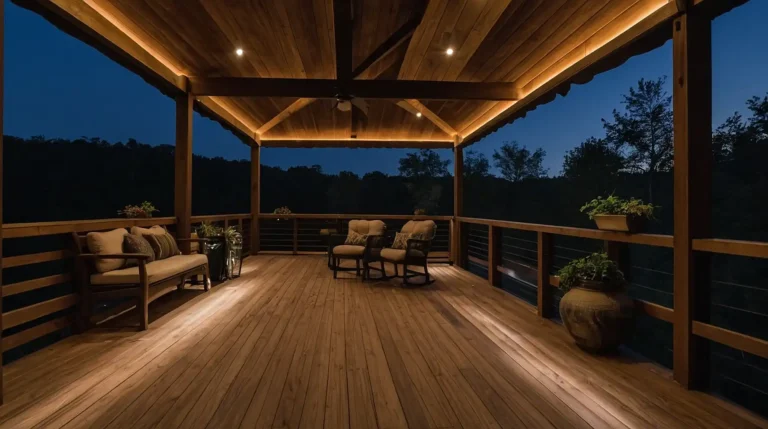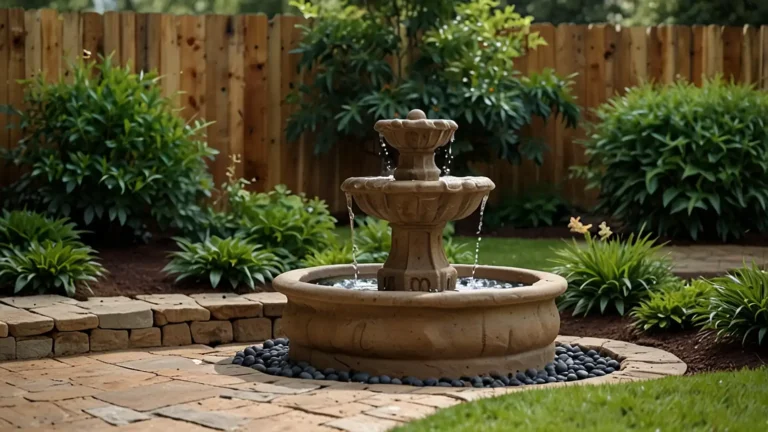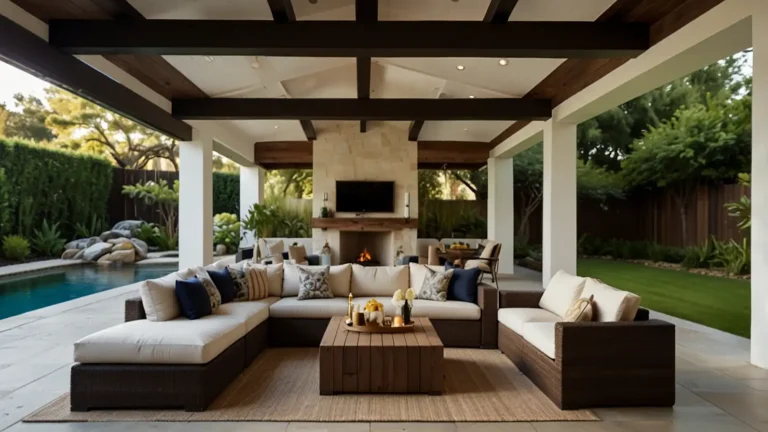27 Creative Garden Edging Ideas for Your Yard: Define Your Space
Garden edging transforms chaotic landscapes into organized, professional-looking outdoor spaces.
Well-defined borders separate lawn from flower beds while preventing grass from invading your carefully planned plantings.
Creative edging solutions add personality while serving practical purposes.
You can achieve stunning results using both traditional materials and unexpected recycled items.
These inspiring ideas will help you create beautiful garden boundaries that enhance your yard’s appeal and functionality.
1: Natural Stone Borders
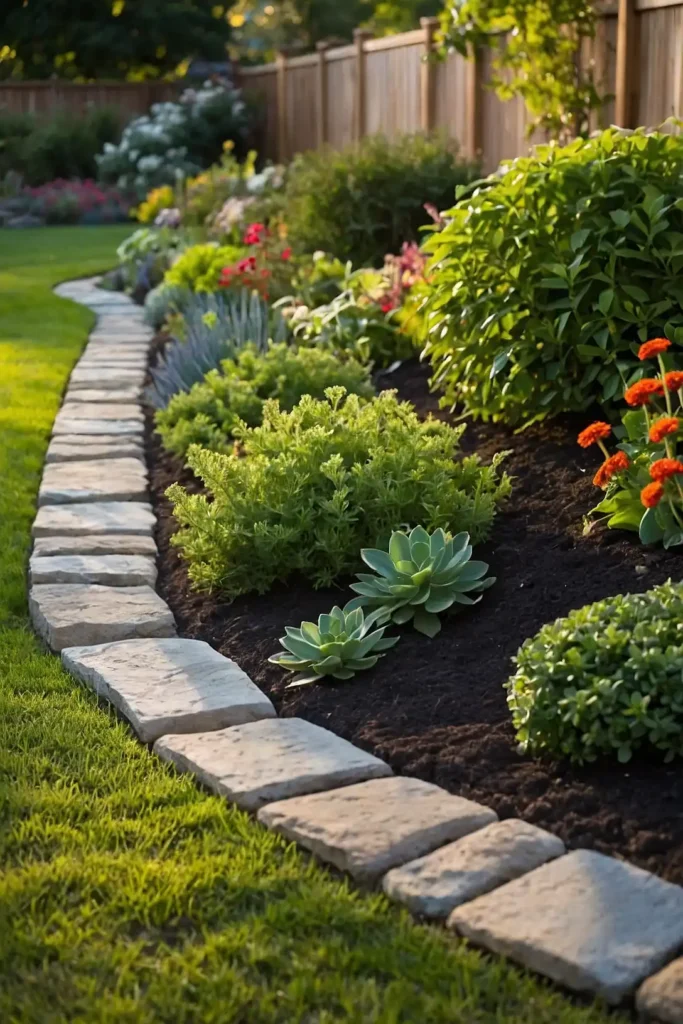
Install natural fieldstone or river rock borders for organic elegance that complements any landscape style.
You’ll create permanent edging while adding texture and natural beauty that ages gracefully over time.
Choose stones that complement your home’s architecture and existing hardscaping elements.
Vary sizes for natural appeal or keep uniform for formal gardens.
Set stones partially into the ground for stability and professional appearance.
2: Brick Herringbone Pattern
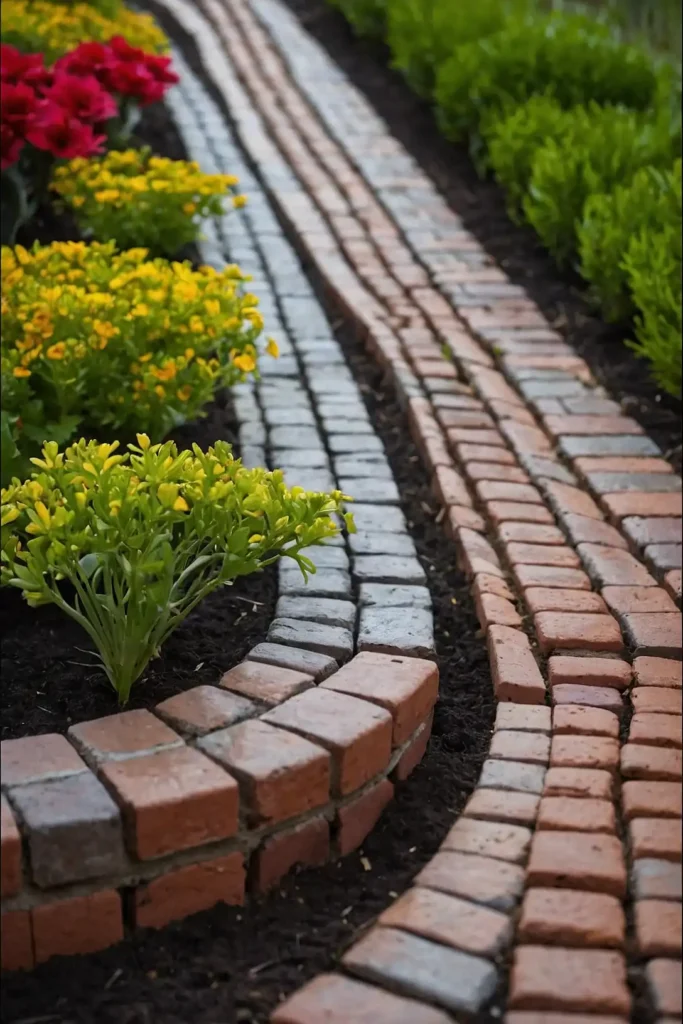
Create classic brick edging arranged in herringbone patterns for timeless sophistication and architectural interest.
You’ll achieve formal elegance while establishing durable borders that withstand weather and daily wear.
Use reclaimed bricks for vintage charm or new bricks for consistent color.
The interlocking pattern provides excellent stability without requiring mortar or concrete foundations.
Angle bricks at 45 degrees to create dynamic visual movement and traditional appeal.
3: Recycled Bottle Edging
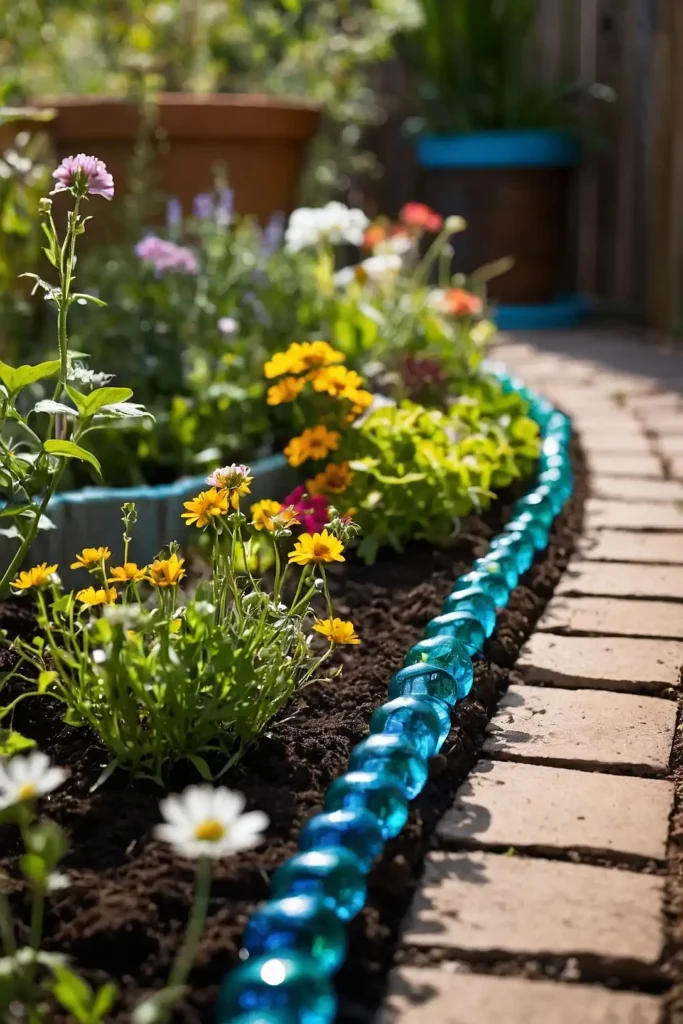
Transform wine or beer bottles into colorful garden edging by burying them neck-down for eco-friendly creativity.
You’ll create unique borders while recycling materials that would otherwise become waste.
Choose bottles in coordinating colors for cohesive appeal or mix randomly for eclectic charm.
The glass catches sunlight beautifully while creating interesting shadows throughout the day.
Ensure bottle tops sit level with ground for safe walking and clean lines.
4: Living Plant Borders
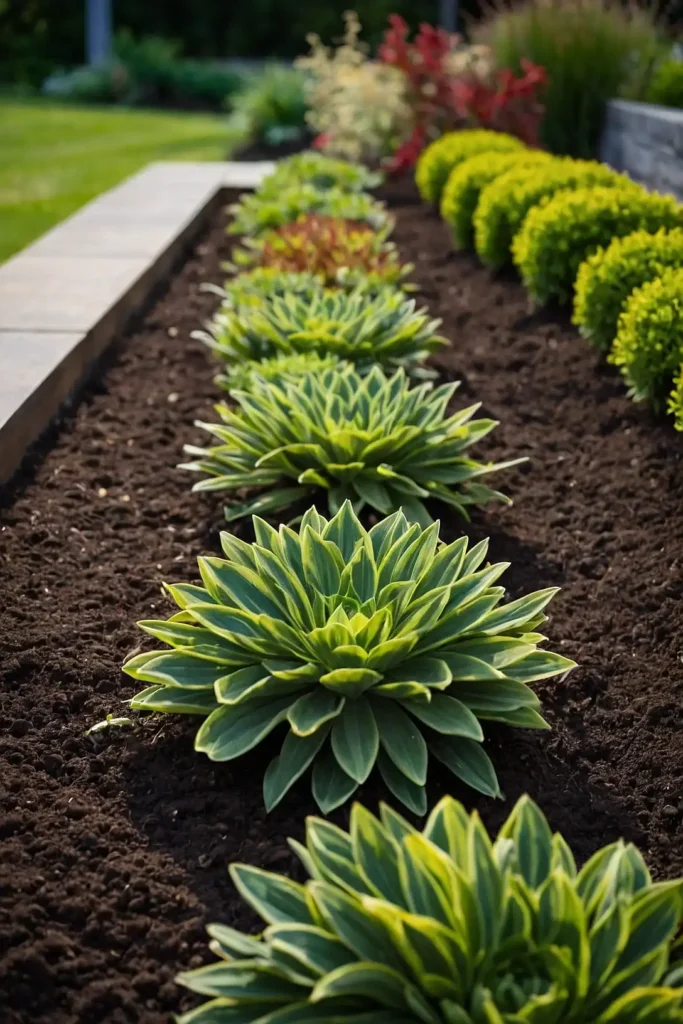
Design edging using low-growing plants like boxwood, lavender, or ornamental grasses for natural beauty that changes seasonally.
You’ll create living boundaries while adding fragrance, texture, and wildlife habitat.
Choose plants appropriate for your climate and maintenance preferences.
Living edges require regular trimming but provide year-round interest and environmental benefits.
Space plants according to mature size for proper coverage without overcrowding.
5: Metal Landscape Strips
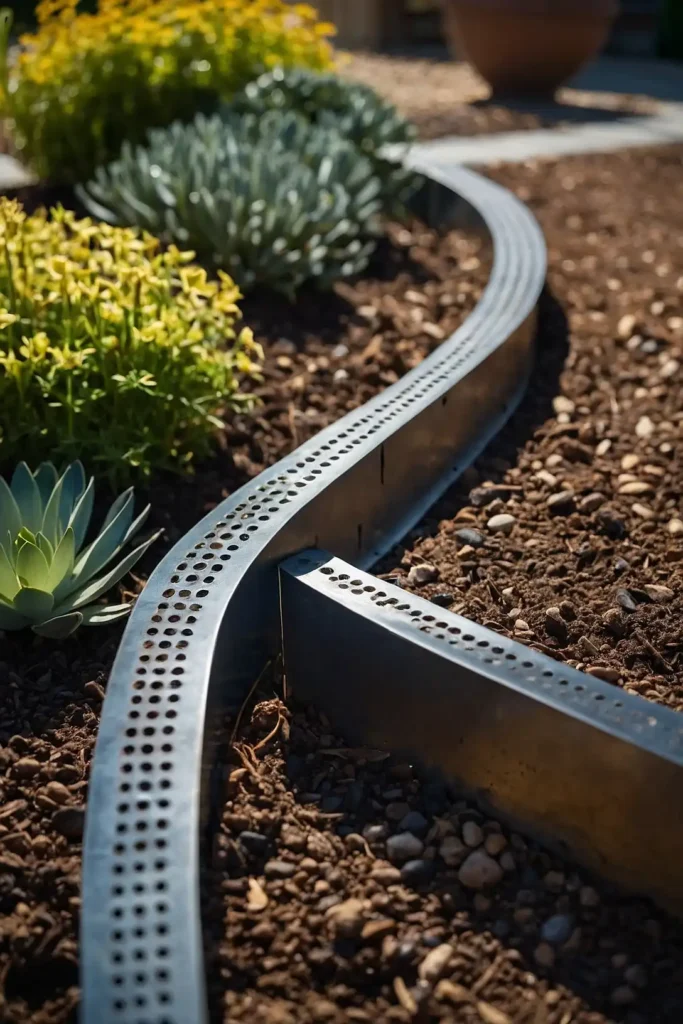
Install sleek metal edging strips for contemporary appeal that creates clean, minimalist garden boundaries.
You’ll achieve modern sophistication while establishing durable borders that require minimal maintenance over time.
Choose aluminum, steel, or corten metal depending on your desired aesthetic.
Metal edging bends easily around curves while maintaining sharp, professional lines.
Bury strips deeply enough to prevent frost heaving and ensure long-term stability.
6: Wooden Log Borders
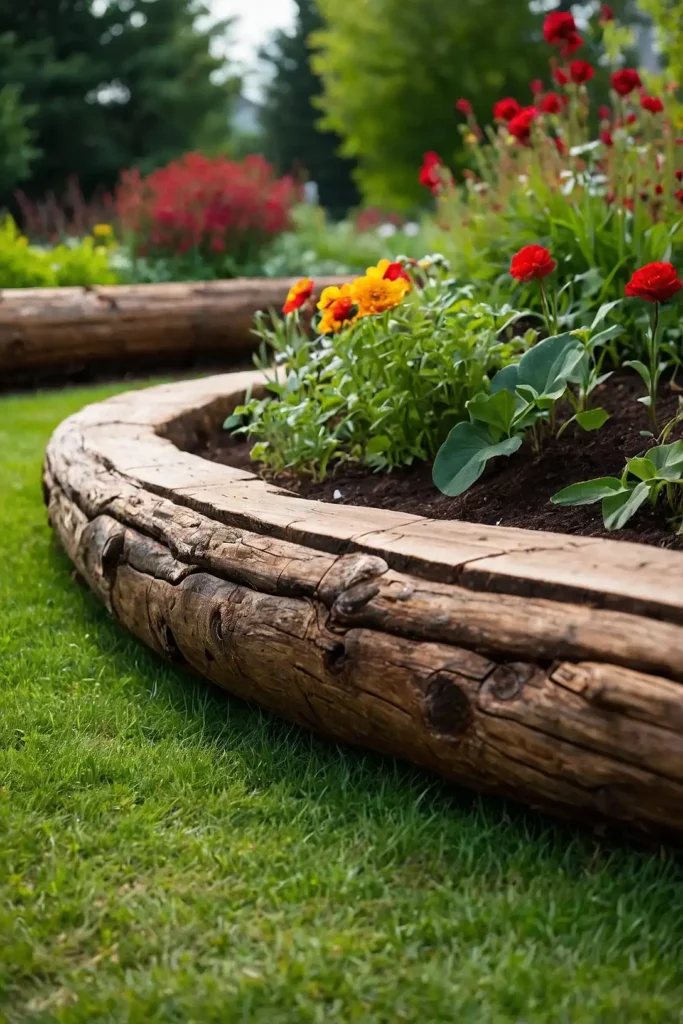
Use split logs or timber rounds for rustic charm that brings natural warmth to your garden edges.
You’ll create organic boundaries while utilizing sustainable materials that blend seamlessly with planted areas.
Choose naturally rot-resistant wood like cedar or treat other woods for longevity.
Logs provide excellent height variation for raised beds and sloped areas.
Set logs at varying depths for natural, informal appearance that mimics forest floors.
7: Decorative Concrete Pavers
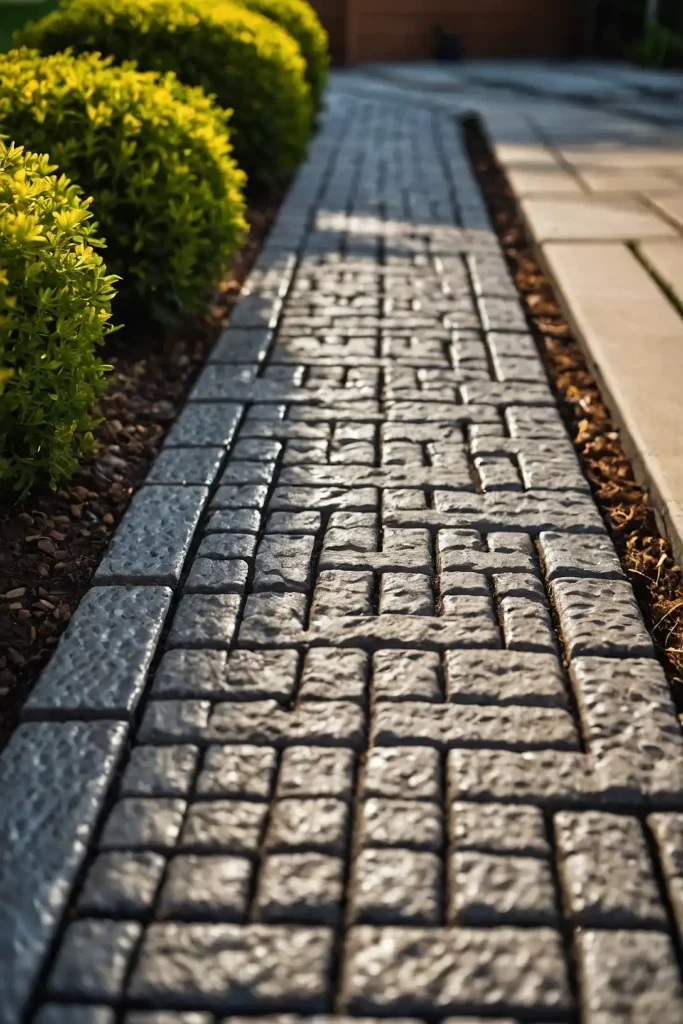
Arrange decorative concrete pavers in patterns for versatile edging that offers unlimited design possibilities.
You’ll create durable borders while choosing from countless shapes, colors, and textures available commercially.
Mix different paver sizes for dynamic appeal or keep uniform for formal gardens.
Concrete pavers handle freeze-thaw cycles better than natural stone in harsh climates.
Install on sand base for proper drainage and easy future adjustments.
8: River Rock Pathways
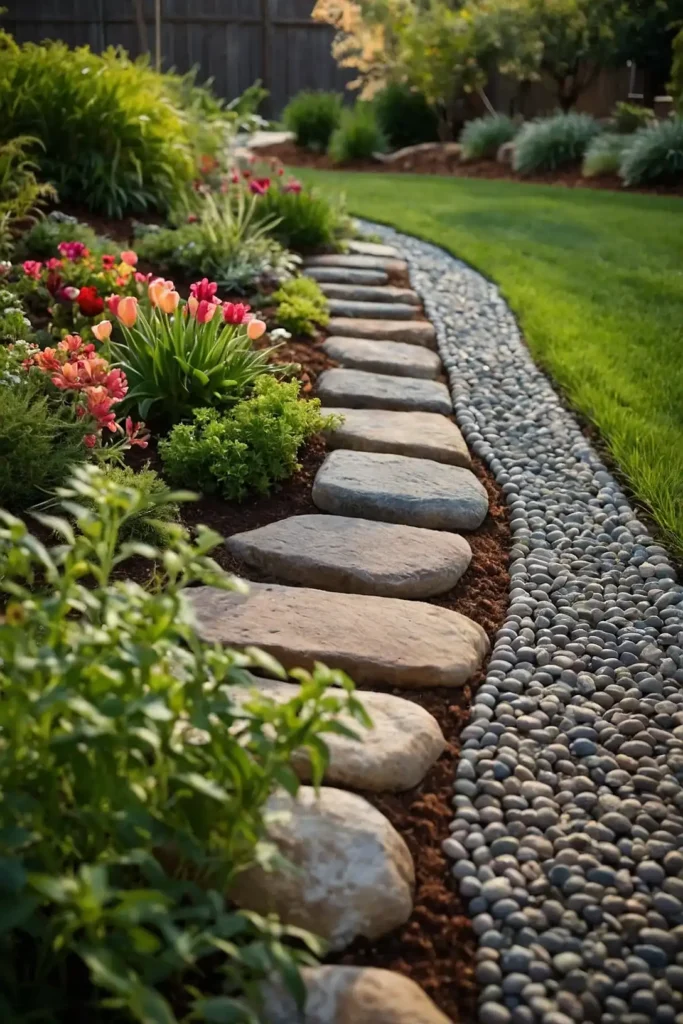
Create flowing river rock edging that mimics natural stream beds for organic beauty and excellent drainage.
You’ll establish permeable borders while adding texture that complements both formal and informal garden styles.
Choose rocks in coordinating sizes and colors for cohesive appeal. River rocks shift naturally over time, creating evolving patterns that remain attractive.
Use landscape fabric underneath to prevent weeds while allowing water penetration.
9: Bamboo Fencing Strips
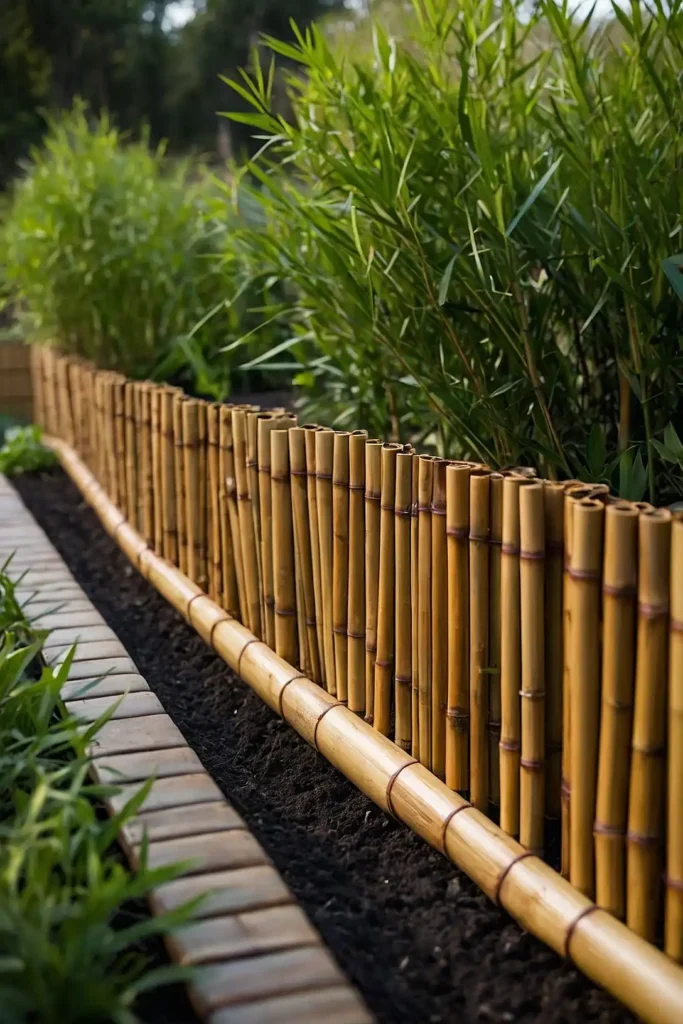
Install bamboo edging for Asian-inspired elegance that brings zen-like tranquility to your garden boundaries.
You’ll create sustainable borders while adding vertical texture and natural warmth.
Choose natural or stained bamboo depending on your color preferences.
Bamboo weathers naturally to attractive silver-gray patina while maintaining structural integrity.
Secure bamboo panels with stakes driven deeply into ground for wind resistance.
10: Reclaimed Brick Patterns
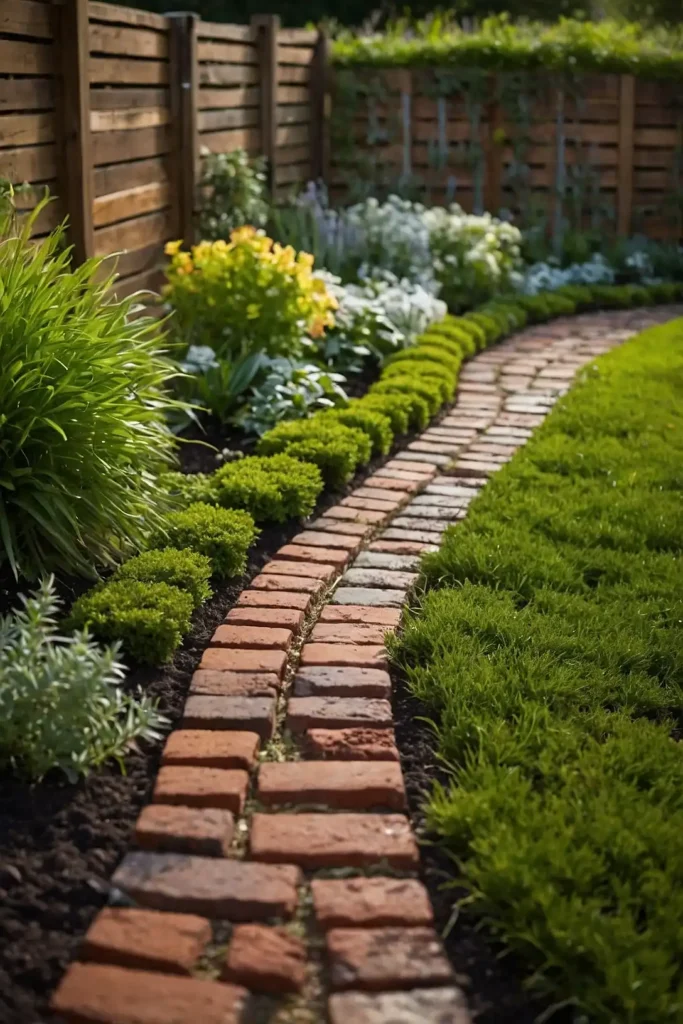
Arrange reclaimed bricks in creative patterns like basket weave or running bond for vintage charm and historical character.
You’ll establish classic borders while incorporating sustainable materials with authentic weathered appeal.
Mix different brick colors and textures for eclectic charm.
Reclaimed materials often feature unique patina and character that new materials cannot replicate.
Set bricks on sand base for stability while allowing natural settling over time.
11: Gabion Wire Baskets
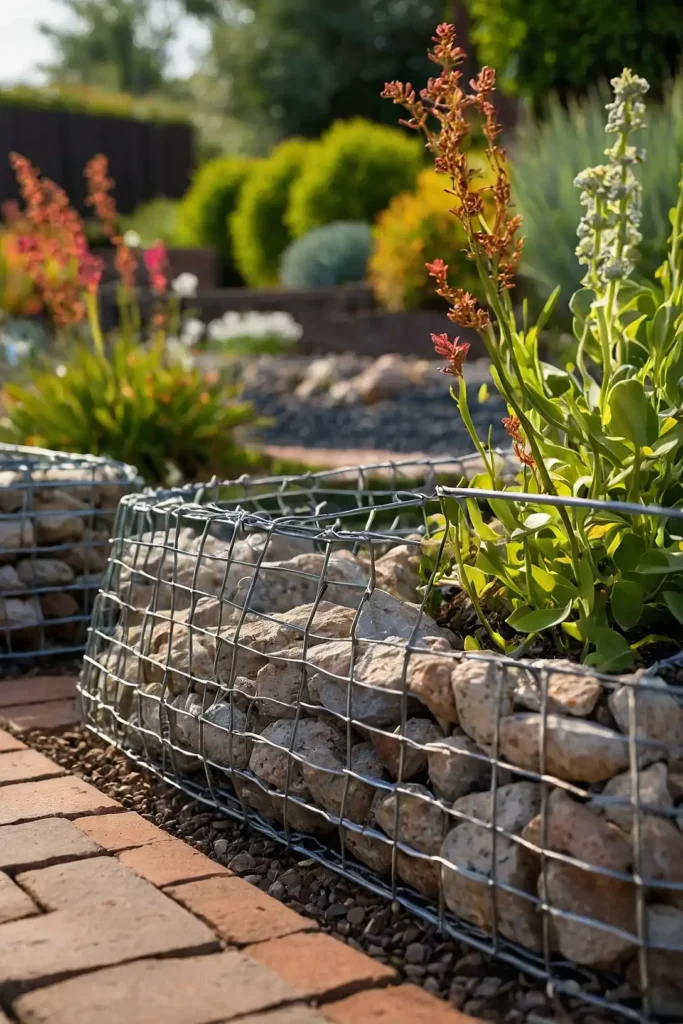
Fill wire gabion baskets with stones for industrial-chic edging that provides excellent drainage and modern appeal.
You’ll create contemporary borders while utilizing materials typically found in commercial landscaping.
Choose coordinating stone fills like limestone, granite, or decorative gravel.
Gabions work particularly well for sloped areas requiring erosion control.
Stack baskets at different heights for terraced effects and visual interest.
12: Plastic Lumber Edging
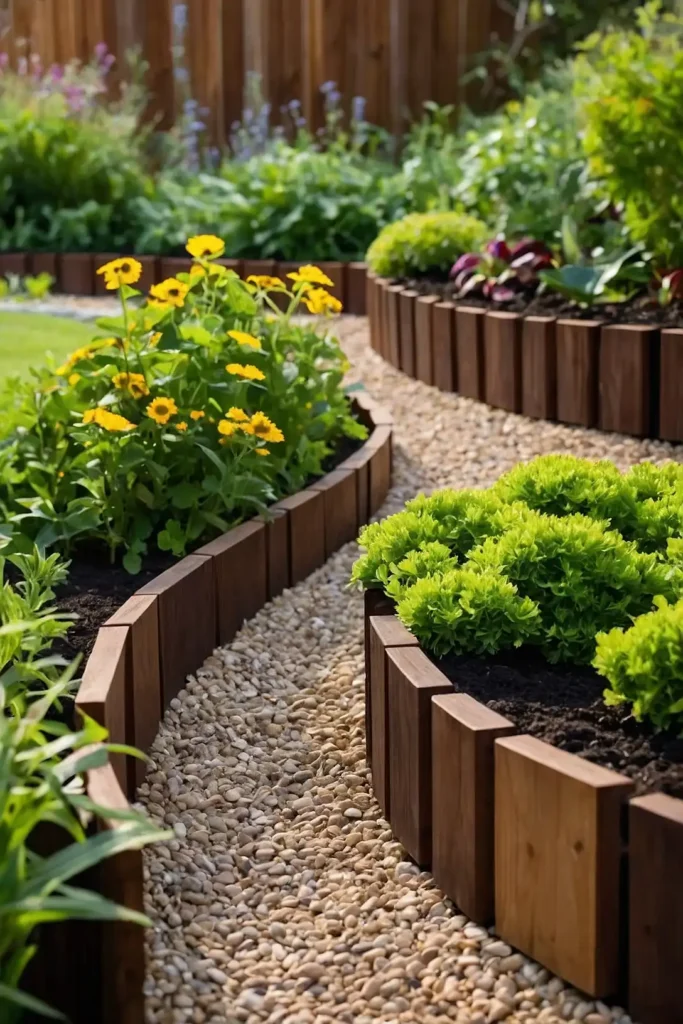
Use recycled plastic lumber for maintenance-free edging that resists rot, insects, and weather damage indefinitely.
You’ll create durable borders while supporting environmental sustainability and reducing long-term replacement costs.
Plastic lumber comes in various colors and wood-grain textures for natural appearance.
This material cuts and installs like traditional wood without ongoing maintenance requirements.
Choose earth tones for natural appeal or bold colors for contemporary design statements.
13: Seashell Borders
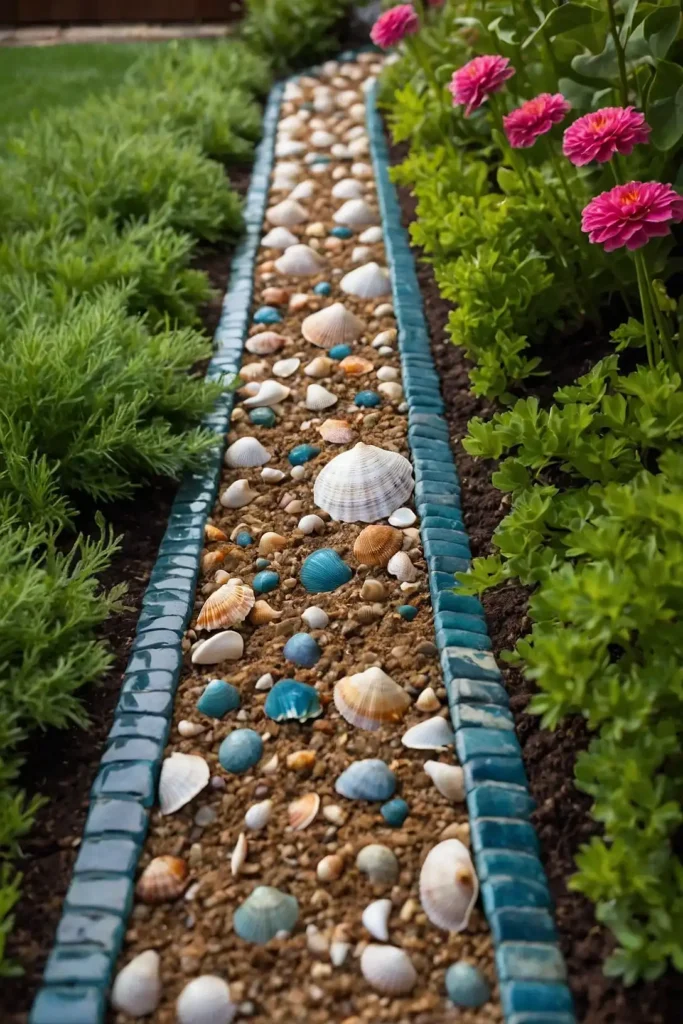
Create coastal-themed edging using collected seashells for beachside charm that brings vacation vibes to inland gardens.
You’ll establish unique borders while showcasing natural treasures and personal memories.
Mix different shell sizes and types for varied texture and visual interest.
Shells work particularly well around beach-themed plantings and coastal garden designs.
Secure shells with landscape fabric or partially bury for stability during storms.
14: Terracotta Pot Edging
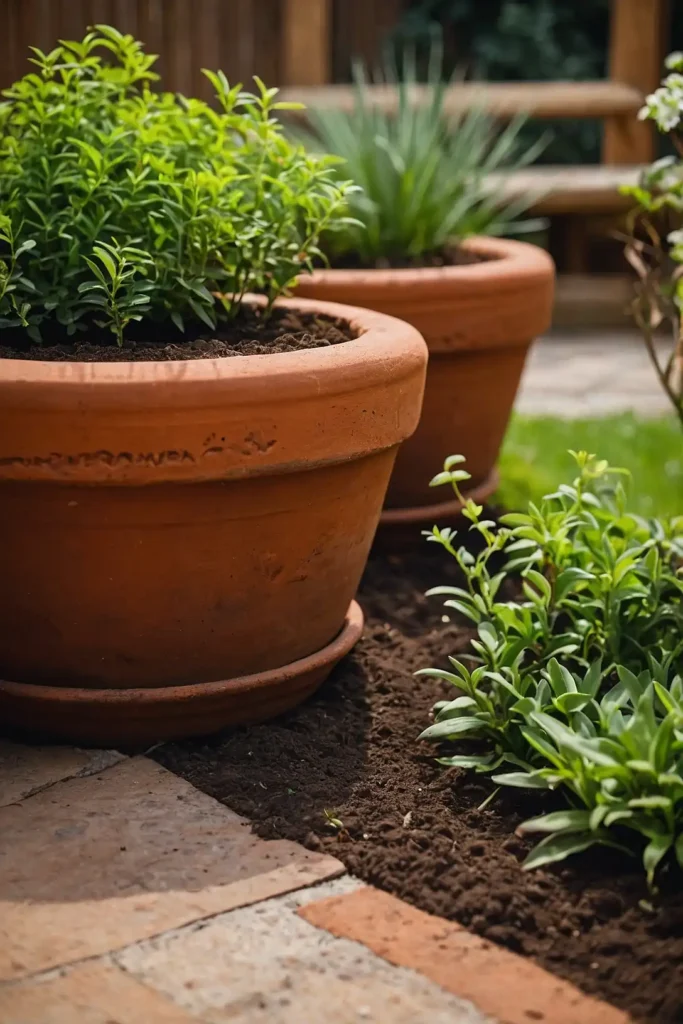
Arrange terracotta pots as edging elements for Mediterranean charm and plant-friendly appeal.
You’ll create warm borders while providing opportunities for seasonal plantings and container gardening within the edging system.
Bury pots partially or use them at ground level depending on desired height.
Terra cotta naturally weathers to beautiful patina while remaining structurally sound.
Plant pots seasonally or use empty for clean, architectural border definition.
15: Railroad Tie Borders
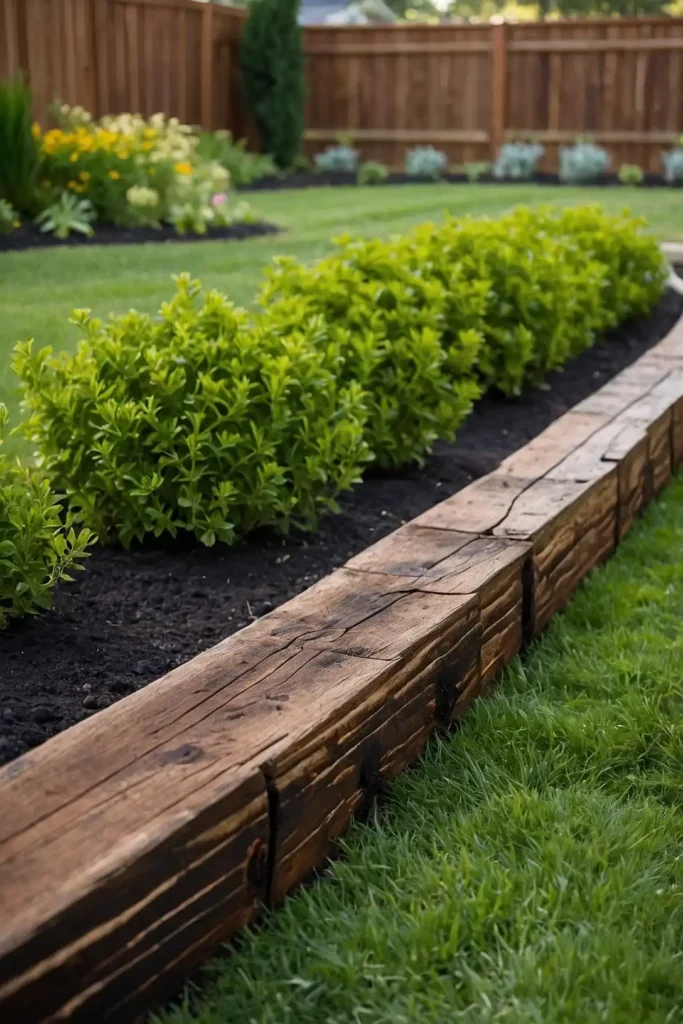
Install reclaimed railroad ties for industrial strength and rustic character that handles heavy traffic areas.
You’ll create substantial borders while utilizing authentic materials with historical significance and proven durability.
Choose properly treated ties rated for landscape use and environmental safety.
Railroad ties work particularly well for raised beds and retaining wall applications.
Drill pilot holes before screwing ties together to prevent splitting and ensure stability.
16: Stacked Slate Edging
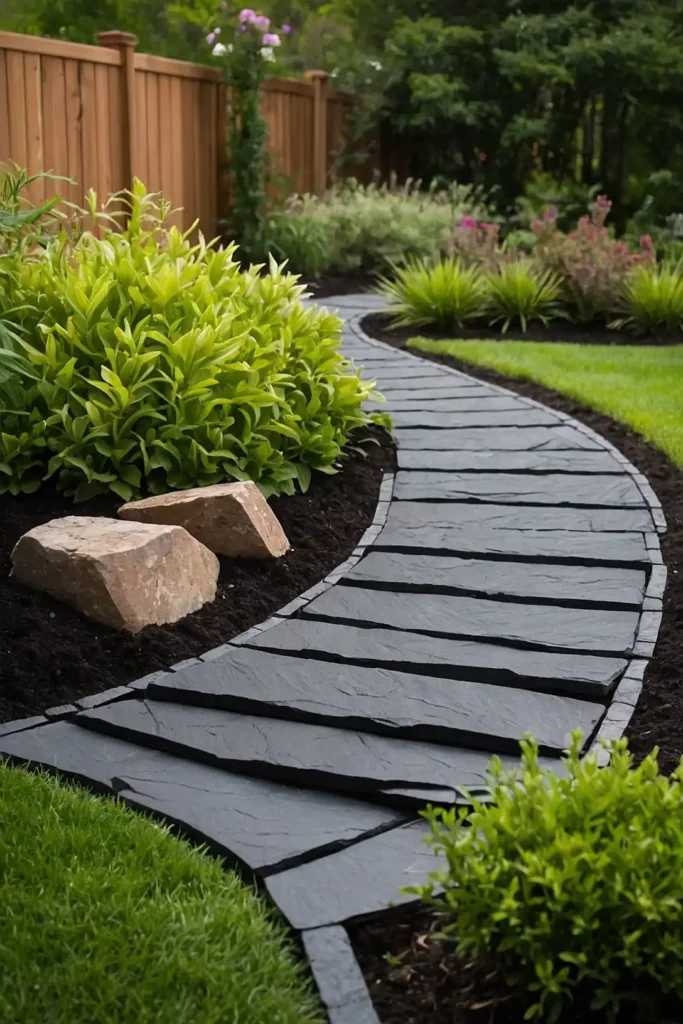
Layer natural slate pieces for sophisticated texture and contemporary appeal that weathers beautifully over time.
You’ll establish elegant borders while showcasing stone’s natural beauty and geological character.
Choose slate colors that complement your home’s exterior and existing hardscaping elements.
Stacked slate provides excellent drainage while creating interesting shadow patterns throughout the day.
Vary stack heights for natural appeal or keep uniform for formal garden designs.
17: Decorative Concrete Blocks
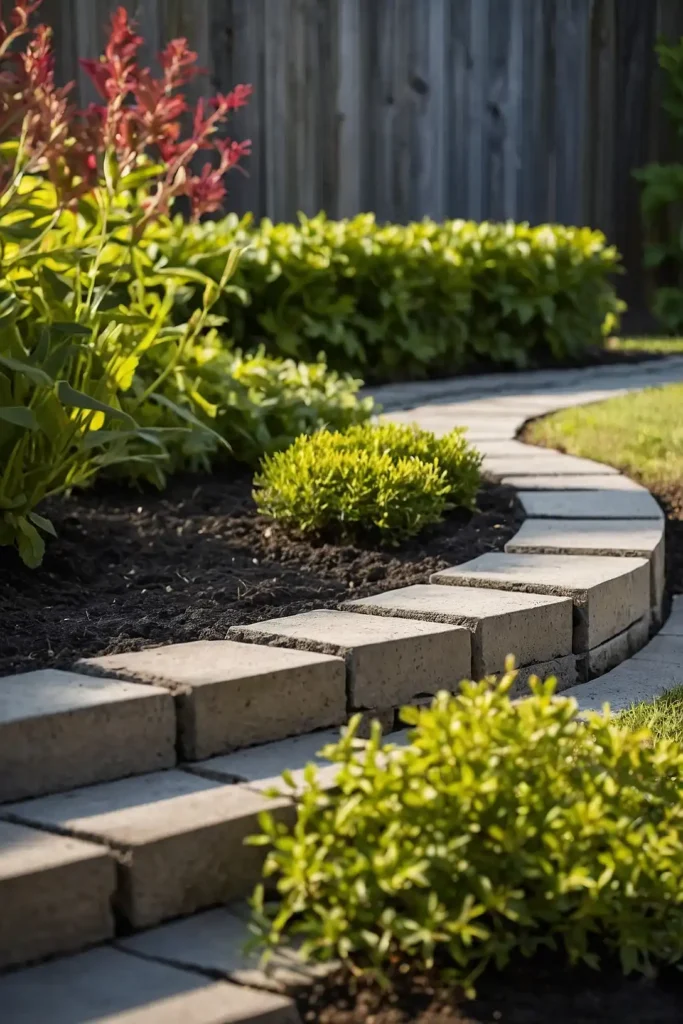
Use decorative concrete blocks in geometric patterns for modern sophistication and unlimited design flexibility.
You’ll create architectural borders while choosing from countless block shapes, sizes, and surface textures.
Stack blocks without mortar for easy reconfiguration and seasonal changes.
Concrete blocks work particularly well for contemporary gardens and geometric landscape designs.
Choose blocks with interesting surfaces like aggregate or stamped patterns for added appeal.
18: Willow Branch Weaving
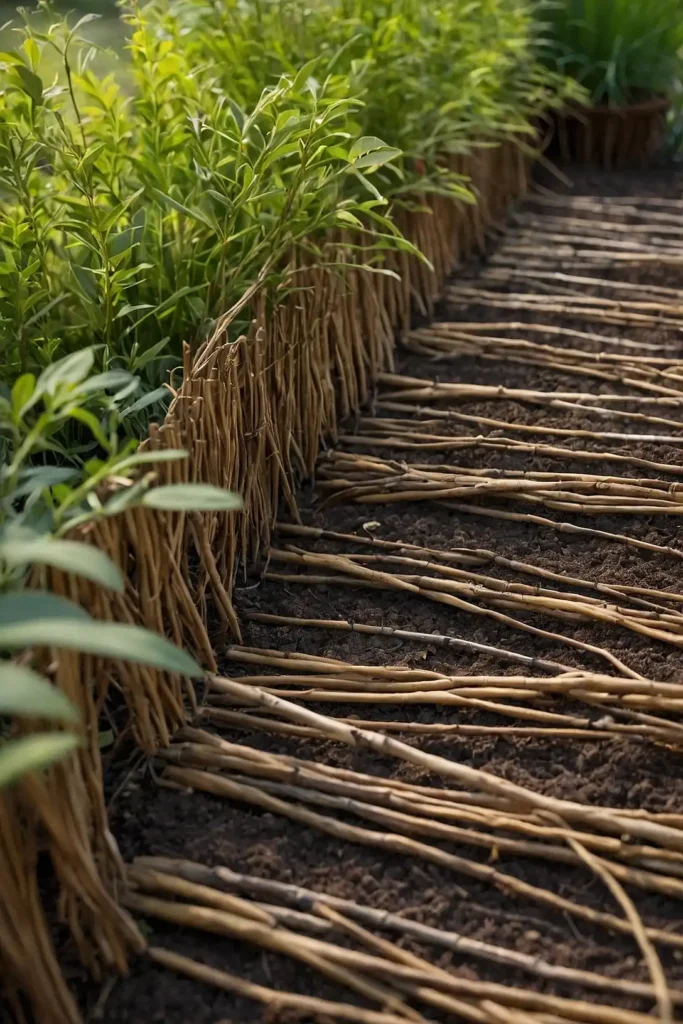
Weave flexible willow branches for organic charm that brings cottage garden appeal to your landscape borders.
You’ll create living borders that may root and grow while providing immediate natural beauty.
Use fresh willow branches for best flexibility and potential rooting success.
This traditional technique works particularly well in informal gardens and natural landscapes.
Replace woven sections annually as branches dry and lose flexibility over time.
19: Decorative Gravel Strips
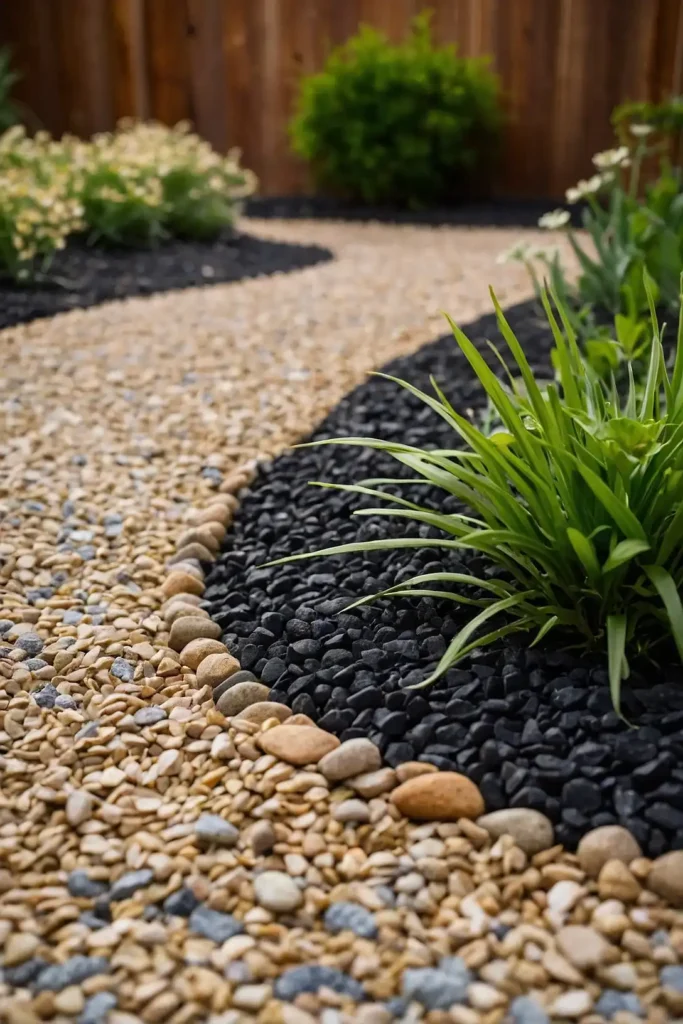
Create defined gravel strips between lawn and planted areas for clean separation and excellent drainage.
You’ll establish low-maintenance borders while choosing from countless gravel colors, sizes, and textures.
Choose gravel that complements your home’s exterior colors and landscape palette.
Gravel strips work particularly well in xeriscape and modern garden designs.
Use edging strips to contain gravel and prevent spreading into planted areas.
20: Artistic Metal Panels
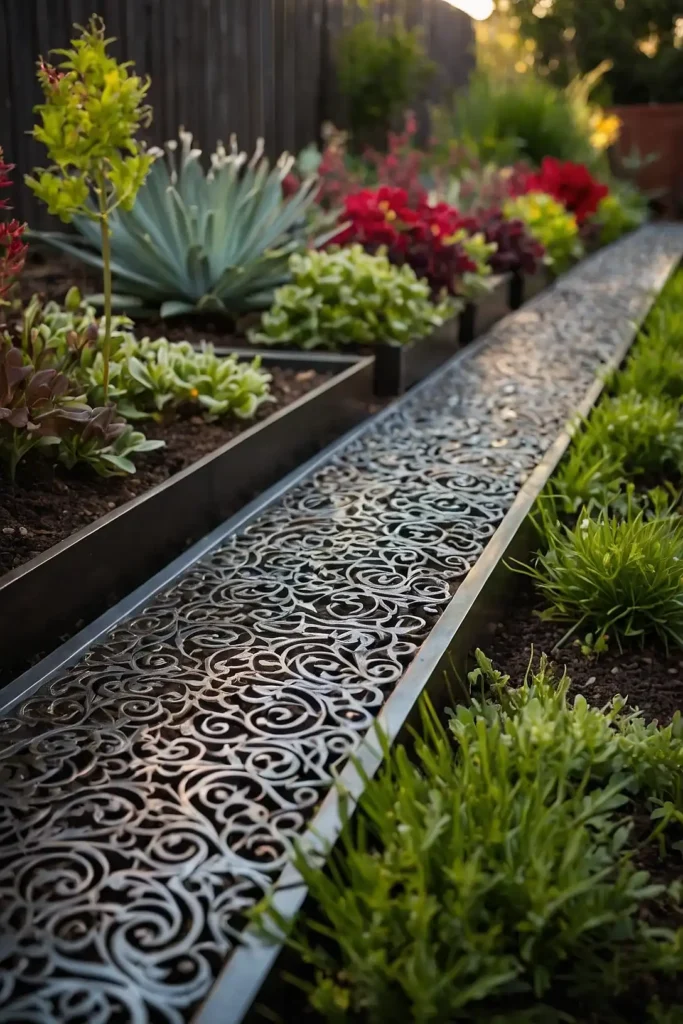
Install custom metal panels with artistic cutouts for contemporary sophistication and personalized garden boundaries.
You’ll create unique borders while showcasing artistic elements that serve as outdoor sculpture.
Choose patterns that complement your garden’s style and reflect personal interests.
Metal panels work particularly well in modern landscapes and urban garden settings.
Use weather-resistant metals like aluminum or stainless steel for long-term durability.
21: Succulent Living Borders
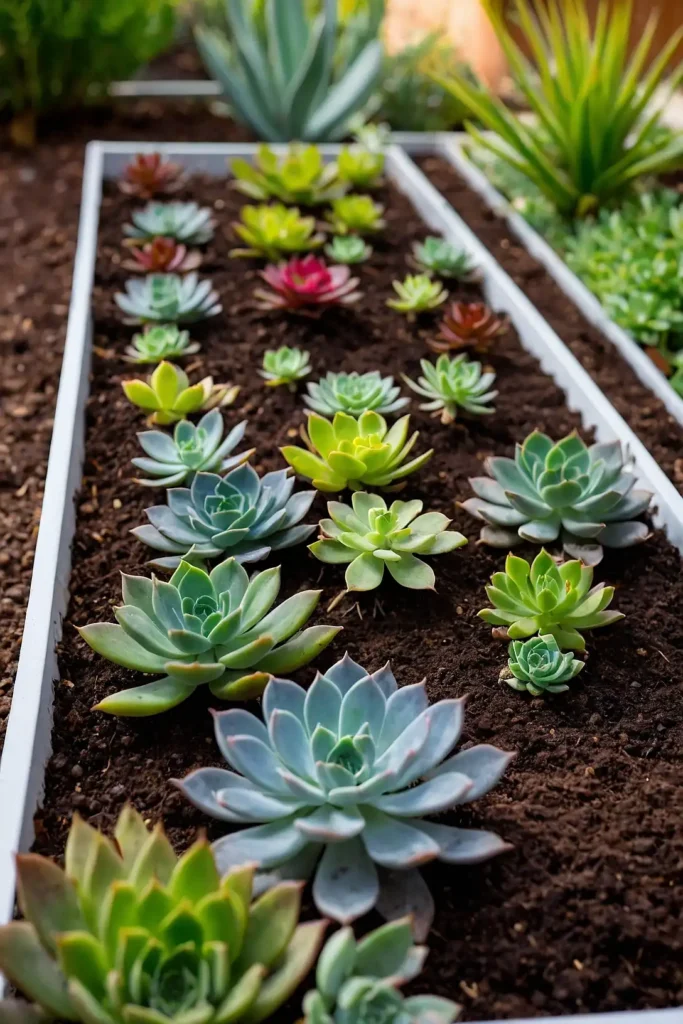
Plant drought-tolerant succulents as living edging for water-wise beauty that requires minimal maintenance.
You’ll create colorful borders while supporting environmental sustainability and reducing irrigation needs.
Choose hardy succulents appropriate for your climate zone and exposure conditions.
Succulent borders provide year-round interest while adapting to seasonal changes beautifully.
Space plants according to mature size for full coverage without overcrowding issues.
22: Ceramic Tile Edging
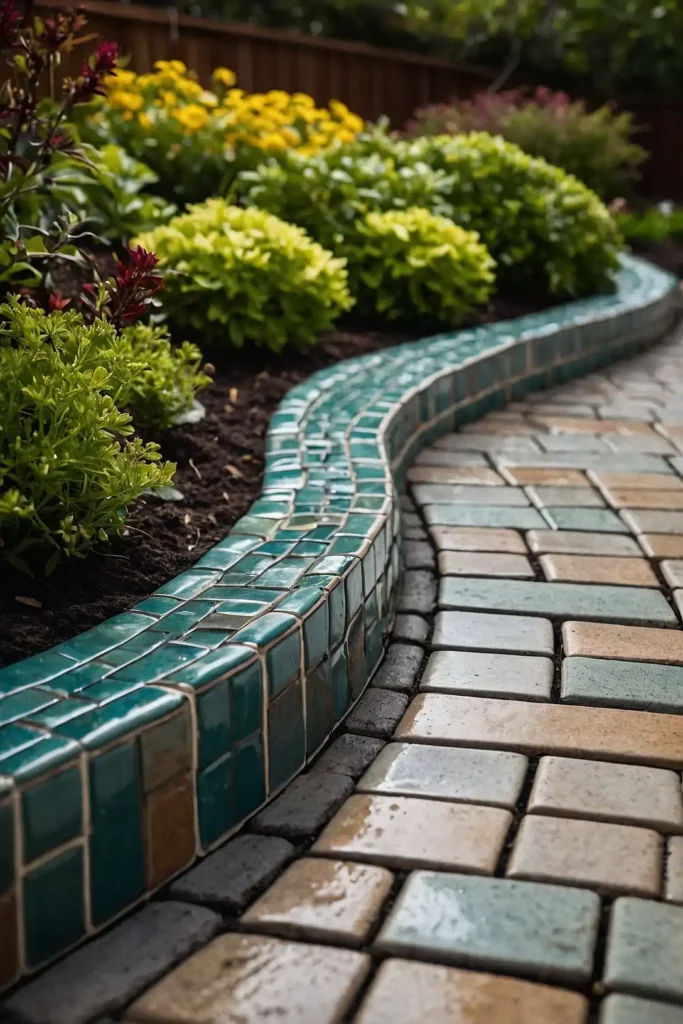
Arrange colorful ceramic tiles for artistic flair and unlimited design possibilities in your garden borders.
You’ll create custom edging while recycling leftover tiles from interior projects or architectural salvage.
Choose weather-resistant tiles designed for outdoor use and freeze-thaw cycles.
Ceramic tiles work particularly well in Mediterranean and contemporary garden styles.
Set tiles in sand or concrete depending on desired permanence and stability.
23: Driftwood Borders
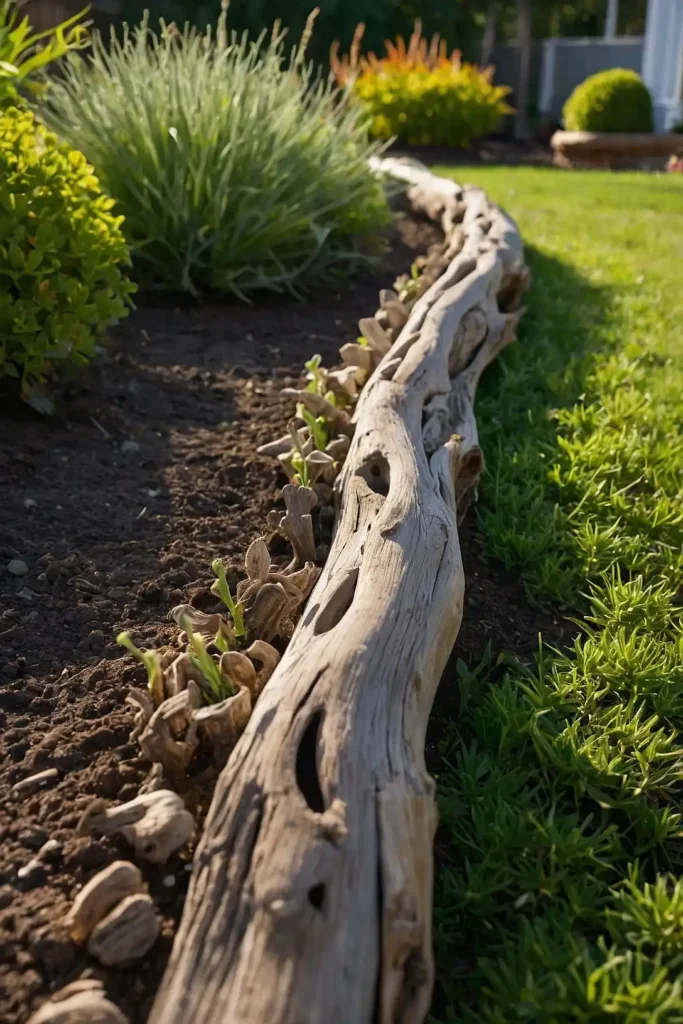
Collect driftwood pieces for coastal charm and natural sculpture that brings beachside appeal inland.
You’ll establish organic borders while showcasing nature’s artwork and weathered character in your landscape.
Choose pieces with interesting shapes and silvered patina for maximum appeal.
Driftwood works particularly well in informal gardens and coastal-themed landscapes.
Secure pieces partially underground or with hidden stakes for wind resistance.
24: Flagstone Strip Edging
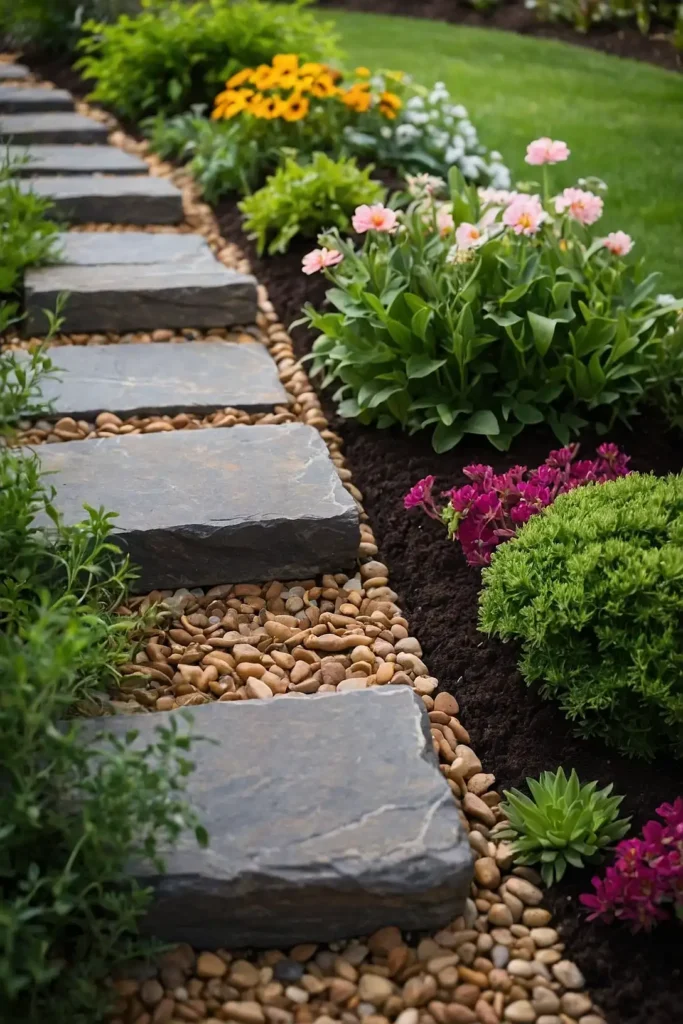
Install narrow flagstone strips for refined elegance and natural beauty that complements both formal and informal gardens.
You’ll create sophisticated borders while utilizing stone’s durability and timeless appeal.
Choose flagstone colors that coordinate with your home’s exterior and existing hardscaping.
Natural stone edges work particularly well with perennial gardens and traditional landscapes.
Set stones level with proper base preparation for stability and professional appearance.
25: Mulch and Timber Combo
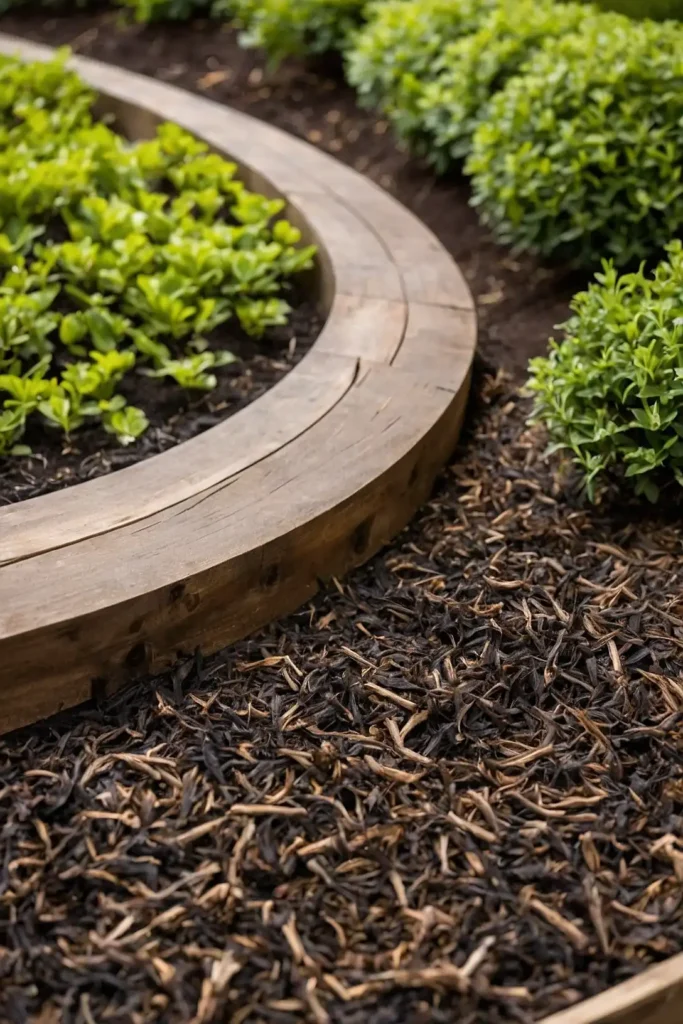
Combine timber edging with decorative mulch fills for practical beauty that suppresses weeds while defining spaces.
You’ll create functional borders while choosing from countless mulch colors and textures.
Use naturally rot-resistant timber like cedar for longest-lasting edging systems.
This combination works particularly well in woodland gardens and natural landscapes.
Refresh mulch annually while maintaining permanent timber structure for years.
26: Steel Landscape Strips
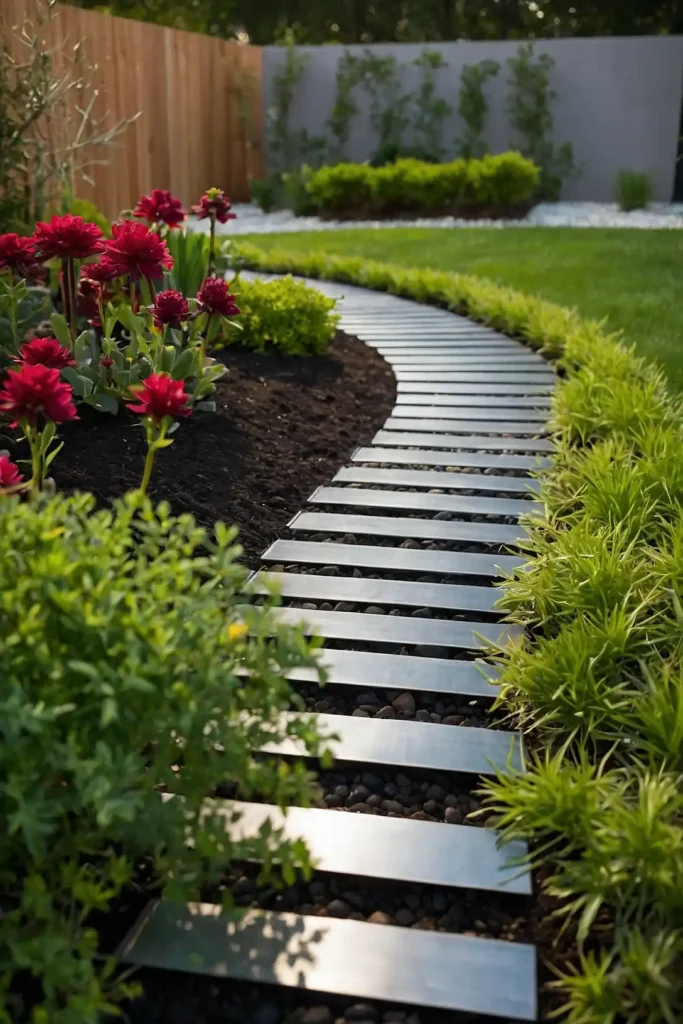
Install weathering steel strips for industrial elegance that develops beautiful rust patina over time.
You’ll create contemporary borders while utilizing materials that improve with age and weather exposure.
Corten steel weathers naturally to stable rust finish that requires no maintenance.
This material works particularly well in modern gardens and architectural landscapes.
Allow proper drainage to prevent steel from sitting in standing water.
27: Creative Upcycled Materials
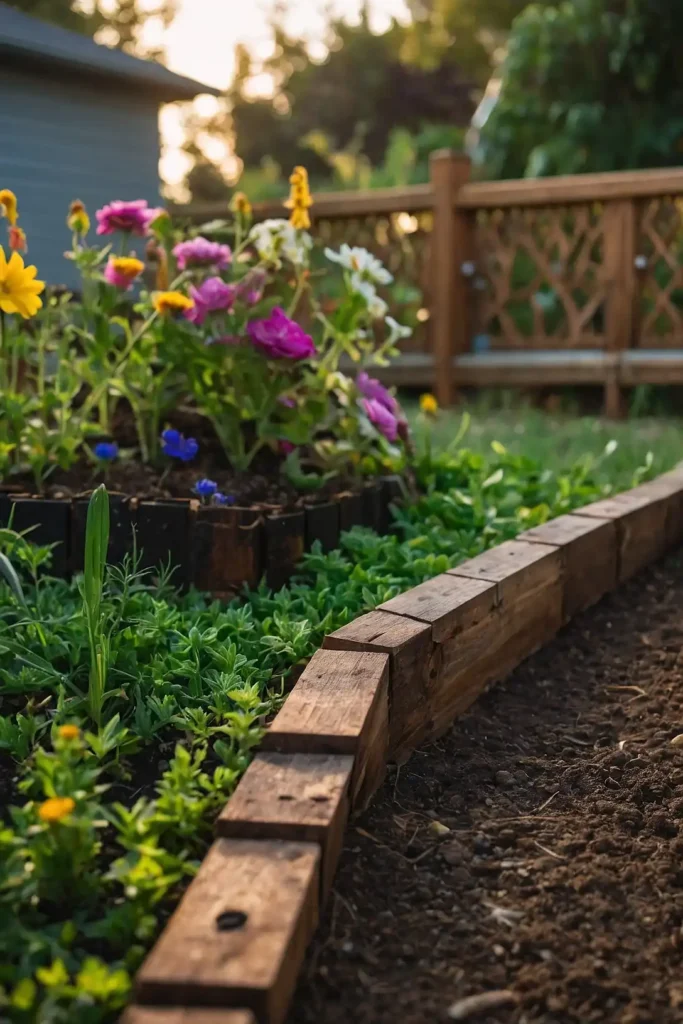
Transform unexpected items like old dishes, bottles, or architectural salvage into unique garden edging.
You’ll create one-of-a-kind borders while giving new life to materials that might otherwise become waste.
Use creativity to repurpose household items, garage sale finds, or construction materials.
Upcycled edging adds personality while supporting environmental sustainability and creative expression.
Ensure materials weather appropriately and remain safe for garden use over time.
Conclusion
These creative edging ideas prove that garden borders can be both functional and beautiful, transforming ordinary yards into organized, professional-looking landscapes with personality and style.

